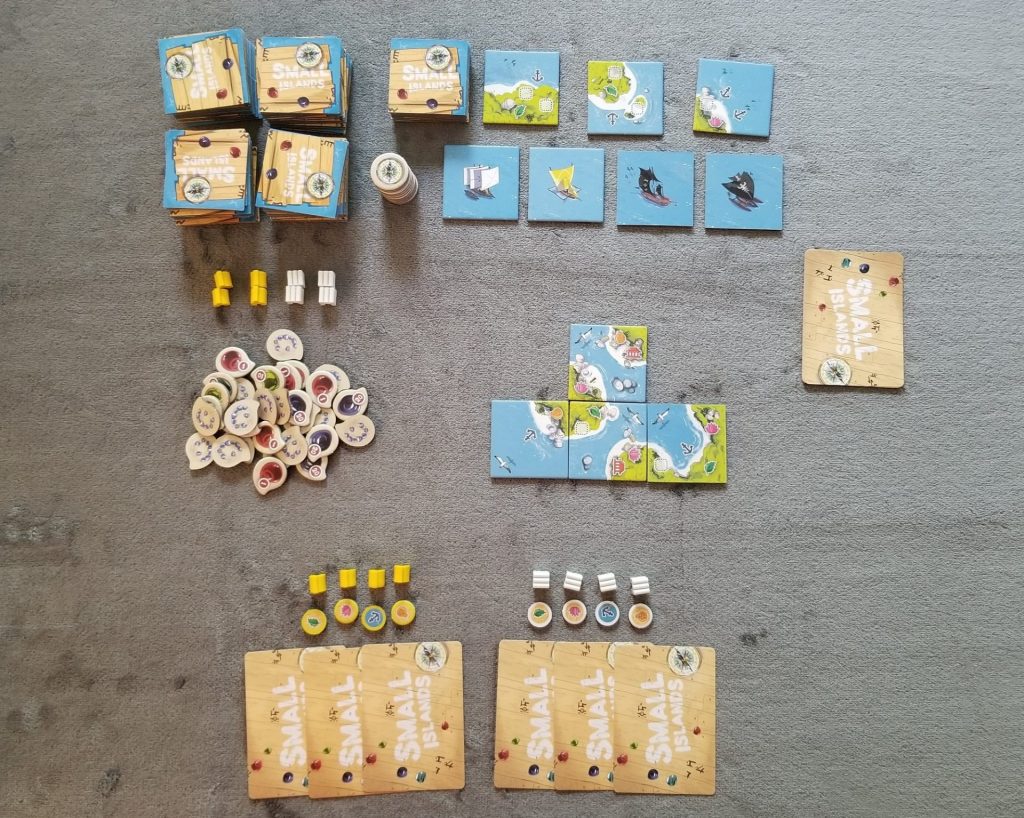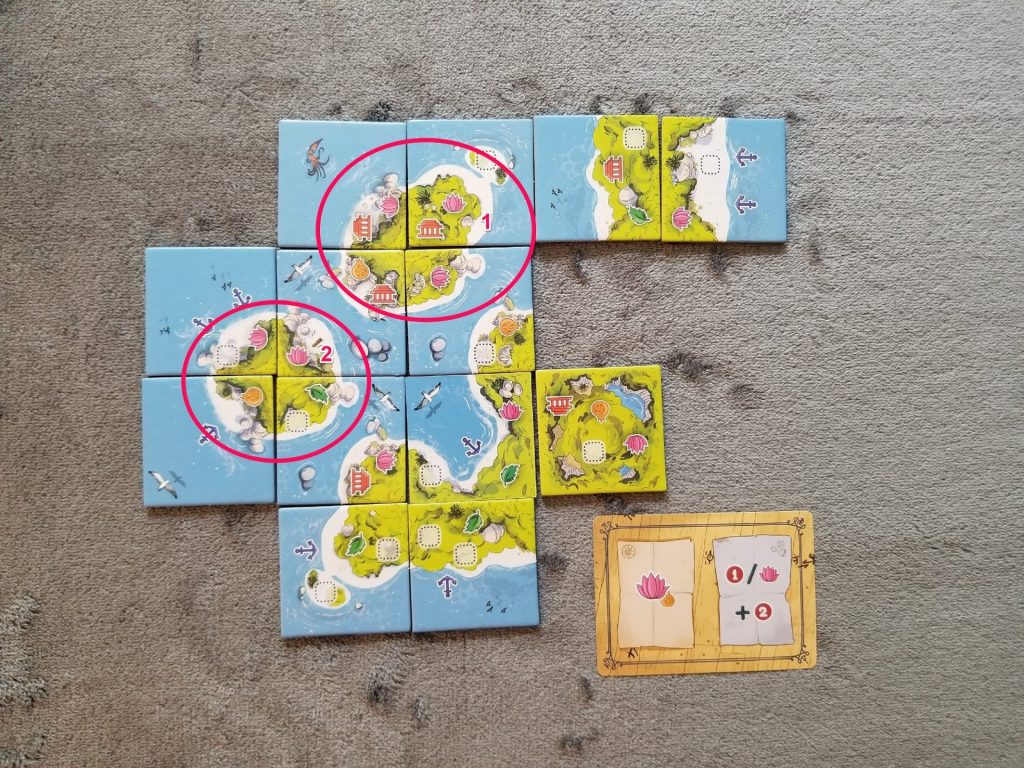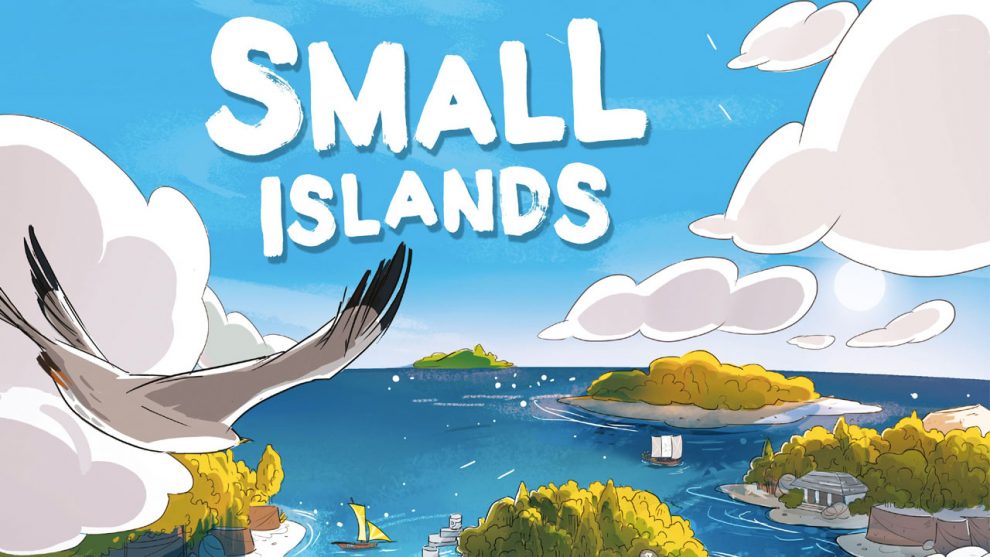Disclosure: Meeple Mountain received a free copy of this product in exchange for an honest, unbiased review. This review is not intended to be an endorsement.
Way out in yonder ocean lies a mysterious archipelago. Spoken of in hushed whispers in seedy taverns, rumors abound of untold riches and lost civilizations. It’s all right there, just waiting for someone brave and bold enough to claim it. And there’s no one braver or bolder than you. So, what are you waiting for? Go get it!
In the game of Small Islands, the players will be creating what the name of the game implies–small islands–by playing Landscape tiles from their hands into a communal display. Each Landscape tile features iconography that factors into the way that players score them. At the beginning of each round, the players will select secret Objective cards that reward them points if the conditions on the cards are met AND as long as the player is able to place one of their Houses on the island. After four rounds, the player with the highest score wins the game.
Of course, this is a high-level overview of the game. If you’d like to learn more about how Small Islands is played, keep reading. Otherwise, feel free to skip ahead to the Thoughts section.
Unfurling the Map
At the beginning of the game, your setup will look like this:

All the Landscape tiles will be shuffled and placed into face down stacks to form a reserve. Then, each player’s Ship tile is placed next to this with any Ship tiles not being used placed grey side up. Beneath this is placed the Navigation tile with three Landscape tiles drawn from the reserve placed face up beside it. Place the shuffled Objective card deck face down beside this.
Each player receives eight houses (four of which are set aside with the Prestige tokens and face down Discovery tokens) and four Bonus tokens in their color. They also receive two Landscape tiles from the reserve and an Objective card which will be kept secret from the other players. With this setup complete, select a starting player, who will use the four Starting tiles to create the initial landmass, and you’re ready to begin.
Navigating the Open Waters
Each round of the game begins the same way. First, six tiles are drawn from the Landscape tile reserve and placed face down on top of the Navigation tile. Then, each player is dealt an additional two Objective cards. They will select one from their hand to use for the current round, one to save for the next round, and one to discard. With that out of the way, the players will take turns doing one of two things: Exploring or Landing their ships.
To explore, a player will take a face up Landscape tile and add it to their hand. Then they will choose a Landscape tile from their hand and add it to the tiles that have already been played. Just like Carcassonne, land must touch land and water must touch water. If there’s an icon on the tile that’s not to their liking, the player can use one of their Bonus tokens to cover it up. These Bonus tokens are double-sided and feature different icons on each side and once placed, can never be moved.
After exploring, a tile is drawn from the stack on the Navigation tile and placed into the face up row of Landscape tiles.
Once the Navigation tile has been emptied of tiles, the players will have the option to land their ship (or one of the grey ship tiles). This ship placement automatically ends the exploration phase, triggering the reward (i.e. end of round scoring) phase.
Grabbing that Booty
Beginning with the player who placed the round ending Ship tile and proceeding clockwise, each player will reveal their Objective card and then place their houses on islands where the scoring criteria is met. Houses can only be placed on islands that have spots for them and where the player does not already have houses. Placing houses is not mandatory. Since you’ll only ever have four houses in total during any given round, you’re limited to placing four. After scoring is finished, you refill your houses from the supply until you have no more than four.
As you can well imagine, since there are only eight houses per player, if you use all of your houses right away, you may wind up without any houses to place during future scoring rounds.
Here is an example layout along with an Objective card:

After scoring your Objective card, return it to the Objective card deck. This deck will be shuffled at the end of the round after everyone has had a chance to score. At the end of the game, players tally up points received during the game, any received from any Discovery tokens that may have been collected from Objective cards, and one point per each port (anchor) on the 8 Landscape tiles surrounding their Ship tiles. The player with the highest total wins.
Thoughts
My first foray into the world of tile laying games was Carcassonne. Watching an entire world take shape from the genesis of a single tile was something that I found fascinating. Not only did Carcassonne foster a love of modern boardgaming in me, but it also began my love affair with tile laying games in general. It still holds true: there’s something undeniably satisfying about watching a world take shape beneath your hands–a phenomenon our editor refers to as “Builder’s Satisfaction”. So, when Small Islands was offered for review, I leapt at the chance to get my hands on this new tile laying title. And I gotta say, I’m pretty impressed with what I received.
The first thing that drew me in was the cover illustration. The idyllic oceanscape sets the scene and does it well. Without even knowing much about the game, you’ve already got a good idea of what you’re getting yourself into. And having played it, you can come back and enjoy it a second time with your newly gained knowledge, discovering things your eyes skipped over before. The usage of brilliant blues and bright greens gives a sense of openness and airiness. The only critique I would have would be on the sense of scale. These islands are really crammed together and it’s a wonder that whatever ancient civilizations were responsible for all the ruins laying about never hit upon the idea of building bridges between them. And either those ruins are very small or those boats are massive in size because they’re roughly equal in scope.
But I digress. We’re here to talk about the gameplay, not to nitpick about the artwork. And when it comes to the gameplay, here’s all you need to know: Small Islands isn’t a very complicated game, but it is a rather tricky one.
The rules are very simple and take only a few minutes to teach. The gameplay itself is anything but. Every single decision in this game is going to have you second guessing yourself about whether or not you made the right one. Did the Landscape tile you just placed help your opponent? What objective card are they holding? Are they playing those tiles because they need the icons on them or are they trying to distract you from blocking whatever they’re truly after? Should you try to do the same?
And this leads you to your next big decision: keep going or Land a ship and bring the round to an end? If you get too greedy, you create scoring opportunities for your opponents. Then again, they’re doing the same for you. I enjoy the push-your-luck mystery that the hidden objectives bring. Without these hidden objectives, I don’t think Small Islands would be a very interesting game. There’s even an advanced mode that lets you build your own objectives that I didn’t even get into.

Overall, it’s a pretty fun game with an interesting premise. But not everything’s perfect. While I love the secret objectives, the hidden scoring makes it hard to gauge where you are in contrast to your opponents. This can be incredibly frustrating, especially if you’re the type of person that likes to be able to visually gauge where each player is at all times. The only indicator of a player’s score is the pile of Prestige tokens they’ve earned and they’re hard to see on the other side of the table.
Also, speaking of tokens, I am not a fan of stacking tokens in board games, especially when they’re kept face down and hidden the entire time. In my opinion, if there are enough tokens to create a face down stack, then there are enough tokens to warrant a drawstring bag to pull them out of. I wish such a thing had been included, but alas, I have to provide my own.
At least I don’t have to provide my own fun. Small Islands takes care of that for me. If you’d like to try it for yourself, it’s freely available on Board Game Arena.












Add Comment